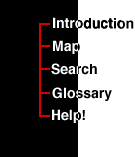

|
 |
A little Quantum MechanicsQuantum mechanics was a revolutionary way of thinking about particles. One major consequence of the theory is that one cannot know both the position and velocity of a particle precisely. Indeed, if one knows the velocity of a particle exactly, then the particle does not even have a position. In such a case, one can speak only of the probability of finding the particle if an experiment were performed to locate it. (Any locate-the-particle experiment, however, would disturb the particle enough so that we would no longer know how fast it is moving.) Quantum mechanics tells us that, before performing the experiment, it might be better not to think of a particle as a little tiny dot, but instead as some entity, like a cloud, that exists everywhere that it is possible a particle might be found. Of course, the cloud would be densest in the places where it is most probable that the particle be found.If we could see the cloud of an electron around the nucleus of a hydrogen atom it might look like this:
If we performed the find-the-particle experiment on the hydrogen atom above many times we'd find the electron most often near the nucleus, where the cloud is densest. Below we simulate the results of many such experiments in a row.
Now before we move on you might ask, "If I cannot ever simultaneously be certain about a particle's location and velocity and you said quantum mechanics also applies to objects of the scale that I encounter in my everyday life, how come I'm able to catch a baseball?" The answer is that quantum mechanics tells us that these uncertainties are quite small, and the larger the object in question, the more precisely we are allowed to know its position and velocity. So again, while Newton's laws of mechanics provide a great description for the position and velocity of a thrown baseball, they won't work for describing a tiny electron shooting across the room. |
|
|